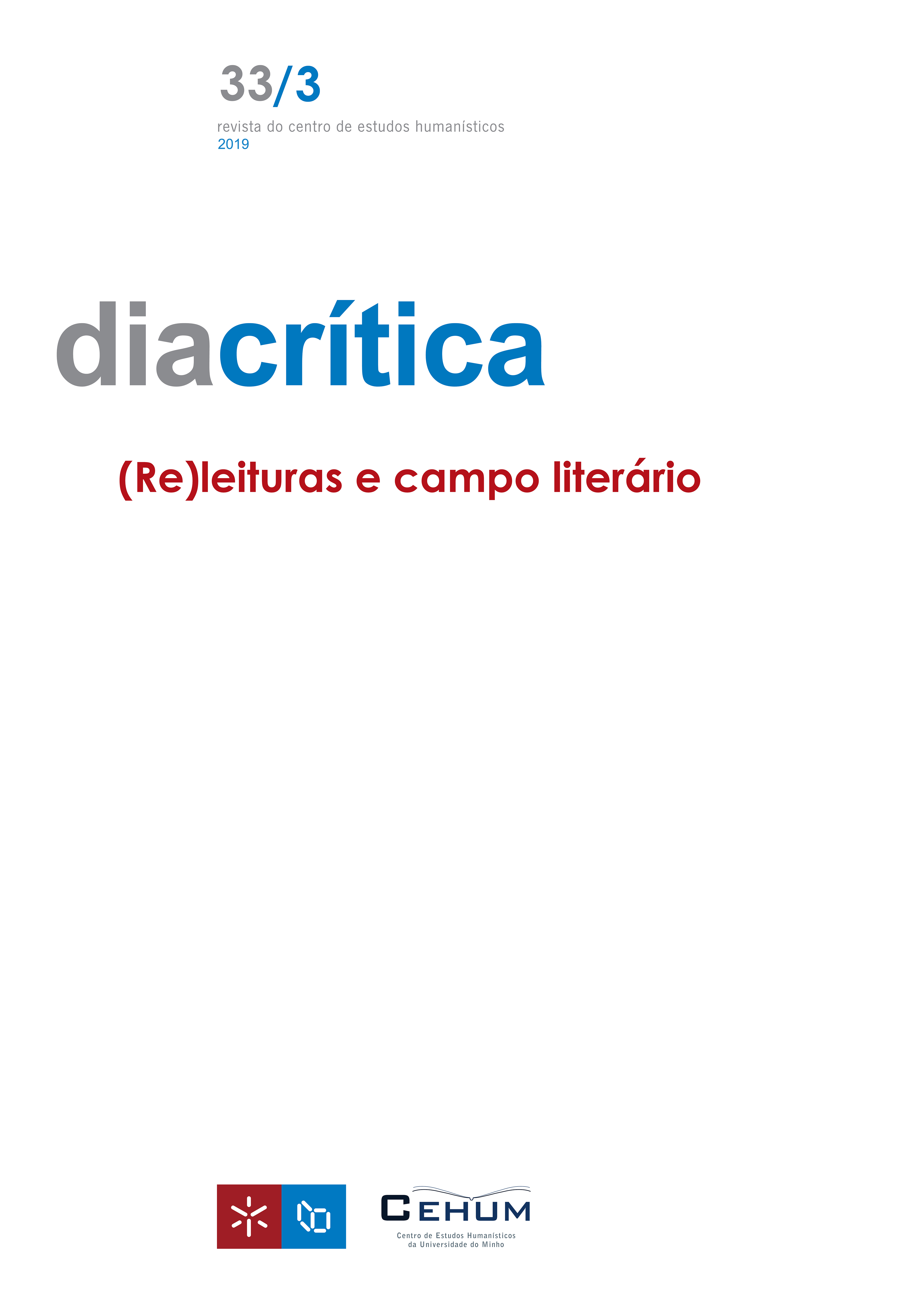Linguagem e poder nas mídias brasileira e portuguesa
DOI:
https://doi.org/10.21814/diacritica.5089Palavras-chave:
Linguística, Referenciação, Mídia, ViolênciaResumo
Este estudopropõe ampliar a discussão teóricasobre referenciação, analisando artigos de opinião que tratam de temas associados à violência, publicados na mídiaem Portugal e no Brasil. Na perspetivateórica, serão discutidos tópicos referentes à correferencialidade e àinferencialidade necessárias para a identificação dos objetos de discurso, seguindo o aporte teórico da Linguística de Texto e de outras pesquisas com viés textual-discursivo, como Fonseca (1992), Fuchs (1992), Apotheloz e Reichler-Béguelin (1995), Koch e Marcuschi (1998), Mondada e Dubois (2003), Cornish (2011) Maalej (2011), Pecorari (2015), Cabral e Santos (2016), entre outros.Convocamos igualmente alguns pressupostos sobre argumentação, alicerçando a reflexão nos estudos de Ducrot (1988), Charaudeau (2008) e Amossy (2008, 2009). Nosso propósito é descrever o comportamento das anáforas como marcadores axiológicos da condução argumentativa dos textos com temática política, polarizando a complexa rede de poder. Pretendemos, portanto, colaborar nos estudos de interface entre referenciaçãoe gênero textual, especificamente em se tratando de gêneros textuais aos quais os leitores têm fácil acesso via Web, demonstrando como anáfora e dêixis podem ajudar a marcar ideologicamente o texto.
Referências
Abbot, B. (2010). Reference.Oxford: Oxford University Press.
Amossy, R. (2008). Argumentation et Analyse di Discours: perspectives théoriques et découpages disciplinaires. Argumentation et Analyse du Discours1, 1–16.
Amossy, R. (2009). The New Rhetoric’s inheritance. Rhetorical and Discourse Analysis. Argumentation, 23, 313–324. DOI: https://doi.org/10.1007/s10503-009-9154-y
Anscombre, J.& Ducrot, O. (1976). L’argumentation dans la langue. Langages,42, 5–27. DOI: https://doi.org/10.3406/lgge.1976.2306
Apothéloz, D. & Reichler-Béguelin, M. (1995). Construction de la référence et stratégies de désignation. InA.Berrendonner&M. Reichler-Béguelin (Eds.), Du syntagme nominal aux objets-de-discours:SN complexes, nominalizations, anaphores(pp. 227–271), Neuchâtel: Institute de linguistique de l'Université de Neuchâtel. DOI: https://doi.org/10.26034/tranel.1995.2643
Benveniste, É. (1995[1988]). Problemas de linguística geral. (Vols. I–II). Campinas: Pontes.
Borreguero, M. (2006). Naturaleza y función de los encapsuladores en los textos informativamente densos (la noticia periodística).Cuadernos de Filología Italiana, 13, 73–95.
Breton, P. (2012). Como convencer? Da comunicação argumentativa à manipulação. EID&A –Revista Eletrônica de Estudos Integrados em Discurso e Argumentação,3, 117–132.
Breton, P.&Gauthier, G. (2001). Históriadas teorias da argumentação. Lisboa: Editorial Bizâncio.
Cabral, A.&Santos,L. (2016). Dêixis pessoal e verbos na construção de um objeto de discurso argumentativamente orientado. Conexões Letras, 15, 25–40. DOI: https://doi.org/10.22456/2594-8962.65800
Carreira, M.H. Araújo (2008). Dêixise proxémica verbal: Percursosenunciativos e processos discursivos. InF.Oliveira & I. Duarte(Orgs.), Ofascínio da linguagem: homenagem a Fernanda Irene Fonseca(pp. 45–53). Porto: Faculdade de Letras da Universidade do Porto.
Cavalcante, M. (2011). Referenciação: sobre coisas ditas e não ditas.Fortaleza: UFC.
Cavalcante, M., Rodrigues, B. B., & Ciulla, A. (2003). (Orgs.). Referenciação. São Paulo: Contexto.
Charaudeau, P. (2008).Linguagem e discurso: modos de organização. São Paulo: Contexto, 2008.
Conte, M.(1999). Condizioni dicoerenza. Ricerche di linguistica testuale. (2ªed. ampl.)Alessandria: Edizioni dell’Orso.
Cornish, F. (2011). “Strict”anadeixis, discourse deixis and text structuring. Language Sciences, 33, 753–767. DOI: https://doi.org/10.1016/j.langsci.2011.01.001
Ducrot, O. (1988). O dizer e o dito. Campinas: Pontes.
Dummet, M. (1990). El carater social del significado. In M. Dummet, La verdad y otros Enigmas (pp. 515–526), México: Fondo de Cultura Económica.
Fillmore, C. (1975). Lectures on deixis 1971. Berkeley: University of California.
Fonseca, F. (1992).Deixis,Tempo e Narração. Porto: FundaçãoEng. A. de Almeida.
Fuchs, A. (1992).Remarks on deixis. Akups, 88, 1–63. DOI: https://doi.org/10.1080/07036339208428982
Kleiber, G. (2001). L’anaphore associative. Paris: Presses Universitaires de France.
Koch, I. (2002). Linguagem e cognição: construção e reconstrução dos objetos de discurso. Veredas, 6(1), 29–42.
Koch, I. (2003). Desvendando os segredos do texto.São Paulo: Cortez.
Koch, I. (2008). Léxico e progressão referencial. Estudos em Homenagem ao ProfessorMario Vilela,vol. 1(pp.263–275).Porto: Faculdade de Letrasda Universidade do Porto.
Koch, I. (2014). As tramas do texto. Rio de Janeiro: Contexto.
Koch, I. &Marcuschi, L.A.(1998). Processos de Referenciação na Produção Discursiva. RevistaDelta, 14, 169–190. DOI: https://doi.org/10.1590/S0102-44501998000300012
Levinson, S. (1983). Pragmatics.Cambridge: Cambridge University Press. DOI: https://doi.org/10.1017/CBO9780511813313
Lyons, J. (1977). Semantics,2.Cambridge: Cambridge University Press.
Maalej, Z. (2013). Framing and manipulation of person deixis in Hosni Mubarak’s last three speeches: a cognitive-pragmatic approach. Pragmatics,23(4), 633–659. DOI: https://doi.org/10.1075/prag.23.4.03maa
Marcuschi, L.A. (2001). Anáfora indireta: o barco textual e suas âncoras.Revista Letras,Curitiba,56, 217–258. DOI: https://doi.org/10.5380/rel.v56i0.18415
Marcuschi, L.A.(2008).Produção textual, análise de gêneros e compreensão. São Paulo: Parábola.
Marques, M. (2011). Argumentação e(m) discursos. In I. Duarte& O. Figueiredo (Orgs.), Português, língua e ensino (pp.287–310),Porto: Universidade do Porto.
Miguel, L., Biroli, F. & Salgado, S. (2016). Meios de comunicação e política: evolução histórica e comparações entre Brasil e Portugal. In H. Prior, L. Guazina & B. Araújo (Orgs.), Diálogos Lusófonos em Comunicação e Política(pp. 43–72), Covilhã: Editora LabCom.IFP.
Mondada, L&Dubois, D. (2003). Construção dos objetos de discurso e categorização: uma abordagem dos processosde referenciação. In M. Cavalcante, B. Rodrigues& A.Ciulla (Orgs.). Referenciação(pp.17–52), São Paulo: Contexto.
Nelson, R. J. (1992).Naming and Reference. London / New York: Routledge.
Palumbo, R. (2014). Referenciação, metáfora e argumentação no discurso presidencial. (Tese de Doutorado em Linguística). São Paulo: FFLCH/USP.
Pecorari, F. (2015).Incapsulatori anaforici e discorso riportato nell'italiano giornalistico: sfruttamenti coesivi della dimensione enunciativa. Bulletin VALS-ASLA, Spécial(1), 227–244.
Perelman, C.&Olbrechts-Tyteca, T. (2005[1958]). Tratado de argumentação. (2ª ed.)São Paulo: Martins Fontes.
Prior, H. (2015). Escândalo político como experiência narrativa. Brazilian journalism research, 11(2), 100–119. DOI: https://doi.org/10.25200/BJR.v11n2.2015.722
Santos, L. &Cavalcante, M. (2014). Referenciação: continuumanáfora-dêixis. Intersecções,12 (1), 224–246.
Santos, L.,Pinto, R.&Cabral, A. (2016). Referenciação em textos jurídicos: da argumentação da língua à argumentação no gênero. In R. Pinto, A.Cabral&M. Rodrigues (Orgs.), Linguagem e Direito(pp. 165–178), São Paulo: Contexto.
Santos, L., Cuba Riche, R., & Teixeira, C. (2012). Análise e produção de textos. São Paulo: Contexto.
Schiffrin, D. (1990). Between text and context: Deixis, anaphora, and the meaning of then. Text,10(3), 245–270. DOI: https://doi.org/10.1515/text.1.1990.10.3.245
Vallauri, E. (2007). The deep relation between deixis and anaphora. In E. Pizzuto, P. Pietrandrea&R. Simone(Eds.), Verbal and Signed Languages–Comparing structures, constructs and methodologies(pp. 309–338), Berlin/New York: Mouton De Gruyter.
Yang, Y. (2011). A Cognitive Interpretation of Discourse Deixis. Theory and Practice in Language Studies, 1(2), 128–135. DOI: https://doi.org/10.4304/tpls.1.2.128-135
Downloads
Publicado
Como Citar
Edição
Secção
Licença
Direitos de Autor (c) 2023 Isabel Roboredo Seara, Leonor Werneck dos Santos

Este trabalho encontra-se publicado com a Creative Commons Atribuição-NãoComercial 4.0.










